Introduction
During the ancient Rome, it was popular to cremate a person once he was dead. The ashes were preserved in urns and then stored in houses and sacred places. However, the Christians did not practice cremation since they believed in resurrection. Thus, they preferred to bury each other just like the early Christians did. Obviously, burying dead bodies required large areas of land (Athnos, 300).
At the peak of the Roman Empire, the Christians did not own enough land to be burying their loved ones or even practice farming. So, the next option was to use catacombs. A catacomb is an underground area where the Christians used to bury their dead. Catacombs strengthened the Christians belief in resurrection and also acted as a place for displaying their art and symbols. Later, catacombs were also used by non-Christians to bury their dead too.
It was initially thought that the Christians used the catacombs as hiding places. However, this assumption was dismissed since the catacombs were located near the highways. Also, the conditions inside them must have been unbearable due to the rotting bodies (Athnos, 367).
The soft rock located in the area made it easy for the Christians to make tunnels or rather catacombs. The use of catacombs changed slightly when Christianity was made legal in the Roman Empire. It did remain as a burial place but also, it was a place of pilgrimage.
A couple of centuries later after cathedrals were made; the catacombs were no longer used as a grave since most of the saints were buried in the church. They were now used as a memorial place for those Christians who were murdered because of their faith. By the beginning of the tenth century, the catacombs were no longer in use and eventually forgotten. This changed in 1578 after an unexpected finding by Antonio Bosio.
Since then, there have been new discoveries of these catacombs; the recent one being discovered only decades ago. Around forty of these graves have been discovered since their first discovery in 1578. As far as Christian art is concerned, these catacombs are critically important since they contain a lot of different Christian art forms (Gough, 313).
Description and History
Among the biggest and well-known catacombs is the Catacomb of San Callisto. The catacomb occupies an area of nearly 15 ha with just over 500,000 graves and nearly 20 kilometres long. The catacomb of San Callisto was constructed at the beginning of 150 AD right under the modern Appian road.
The catacomb is named after Saint Callixtus who was overseeing its expansion between 217 and 222 AD. It was further extended in the years between 366 and 384 under the then current pope; Pope Damasus. The expansion was a part of his attempt to boost the adoration of Roman martyrs. During this expansion, basilicas were built in the catacombs so as to make it easy for the worshipers to reach the martyrs’ graves.
The San Callisto Catacomb has 4 levels with 5 parts; however, the 2nd is the only one which tourists are allowed. All the rooms are connected to each other with channels. On the walls of the chambers, there are large holes which each were big enough to bury about 2 or 3 people.
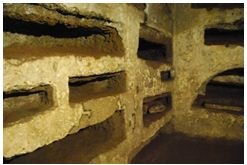
Figure 1
Other than that, there are cubicles large enough to bury several people. These cubicles were used to bury people belonging to one family (see fig. 1). Perhaps the most famous part is the graves of the popes, saint Cecilia and sacraments. These areas are a treasure of holy Christian memoirs.
At the end of the third century, two other areas were built, namely: Saint Gaius and Eusebius (Gough, 389). Early in the following century, the western section was constructed and before the century ended, the Liberian section was complete. All the later sections had pretentious underground structural design.
Pope Damasus replaced the stairway to the crypt of the popes with a more contemporary one. In the crypt of the popes, 9 affiliates of the major seminary of priests were buried there together with 8 legislatures of the clerical hierarchy. On the walls near the affiliate’s graves, their names have been inscribed in Greek language.
On the further wall, Pope Sixtus’ grave was there; he died as a result of persecutions which occurred in the city Valerian. On his grave, there are inscriptions written calligraphically as proposed by Pope Damasus (Athnos, 495). The grave beside Sixtus is Pope Cecilia’s; although his remains were moved to a cathedral by Pope Paschal the first. On the nearing walls, there is a ninth century fresco depicting Pope Cecilia speaking to God and the bust of Pope Urban the first.
A little further away, there is a walkway that leading to cubicle graves of the sacraments. Without a doubt, the most noticeable features in this section are the artworks. There are frescoes painted between 200 and 250 AD giving a clue of baptism and Eucharist. Next to this region, there is the St. Miltiades section. In it, there is a child’s coffin with relief sculptures showing various events in the bible.
In the St. Gaius and Eusibius section, the tombs are arranged on two sides of the wall facing each other. The graves of both Pope Gaius and Eusebius are found in this chamber and are exactly opposite each other. Unlike Pope Gaius, Eusebius did not die in Rome; he died in Maxentius where he was cast out. His remains were later brought to Rome and finally into his grave. Like in the crypt of pope, Damasus inscribed some readings on the wall too.
The grave of Pope Cornelius can be found in the Liberian section. The initial writings on the coffin are still present; the writings have acknowledged him as a martyr. On the sides of the coffin, there are fabulous paintings dating back between 600 and 700AD with Byzantine style. The paintings show four people and among them is Cornelius.
The other three were popes too and two of them are Africans (Gough, 459). The next cubiculum are the graves of some of the earliest people to be buried in the San Callisto Catacombs. On the roof, there is one of the famous frescoes depicting a good shepherd. On another wall, there is a fresco showing fish and loaves.
Artworks
The type of art found in this catacomb is dissimilar from the normal Roman art of the time. Probably this is due to the fact that, these art works try to show signs of anticipation and optimism in times when death crept in the Christian society.
The paintings are figurative; they try to depict a religious experience instead of a highly creative enjoyable piece of work. It seems that up to today, some of the symbols found there like the anchor, still have an importance in Christianity. However, most of the symbols represent the maltreatment of the Christians by the Roman regime (Lassus, 455).
The type of art found in this catacombs, falls under Paleochristian art. Paleochristian art, which lasted between 1st to 6th centuries, has been influenced by both the traditional Greek and Roman art. This catacombs hosts among the first Christian art presently known. For example, most of the limestone sculpture was done between 200 and 400AD. The graffiti and inscription might have been adopted from the Mediterranean communities.
The Egyptians and the Etruscans have been known to paint and put sculptures in their tombs. It is not certain whether these communities influenced the Christians to paint in their graves, but there are major similarities. Just like the Egyptian tomb paintings reveal a lot about their lifestyle, so do the art found in the catacombs (Milburn, 207).
The paintings in the catacombs show particular people while others depict some aspects of the Christian life. The artists in the catacombs, who were mainly employed by the Christian leaders, were trying to show that, despite of the bitter death that surrounding the chambers, there was still hope in resurrection (Lassus, 501).
The artists seemed to have had limited number of colours and also used aggressive brushstrokes which were similar to the ones commonly used in the 18th century.
The result is a fresco having a vivacity of colour and dynamism. Nevertheless, unlike the 18th century paintings, which were known to obscure the sight, the images in the catacombs were clear and evoked purpose. Some of the frescoes in this catacomb have completely faded, and others are slowly fading.
The free movement of air and the differing temperatures have been a major contributor of the fading. This contrary to the assumption that time has affected the clarity of the frescoes. Conversely, the sculptures are unaffected by time or any other environmental factor. The sculptures are of stone material and they are well preserved (Milburn, 376).
The sculptures in the San Callisto Catacombs can be separated in 3 ways. The sarcophagus sculptures are basically classic coffins made from limestone.
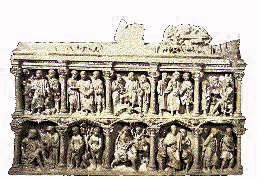
Figure 2
They had different sizes; some were small enough to fit a baby while others were big enough to fit a two married people. Some of the coffins had reliefs on the sides and even on the top marble (see figure. 2). Others only had one or two side sculptures, especially the front side. The relief sculptures on the coffins showed a part of Jesus’ life, a significant event in the bible and not so often, a figure of the departed.
The second type of sculpture is the common statue. The statues found in the catacombs are mainly Jesus Christ who is shown to be a good shepherd. How Jesus is shown in these sculptures, is almost similar to how the pagans sculptured the figure of Orpheus.
Jesus is shown to be carrying a sheep on his shoulder and Orpheus the same thing. The major difference is that Orpheus has a flute on the side. The final type of sculpture is inscriptions. There are inscriptions in Latin and Greek on the wall. Also, there are symbols and signs inscribed on the wall (Lassus, 602).
The graffiti is almost everywhere in the catacomb and it dates from the time the catacombs were made up to the more recent times. The early artists used uncomplicated tools to write messages on the walls and graves.
Also, writings dating as late as the 18th century are present. These writings have been made by some of the pioneering explorers in the catacombs. One of the archaeologists in the 18th century felt that he had to write on the walls after he unintentionally exposed one of the chambers.
Also, the first pilgrims to worship in the catacombs left Christian messages on the wall and tombs. The graffiti left in the catacombs is of great importance to modern Christians and archaeologists. To an archaeologist, it reveals the kind of lifestyle the early Christians had. On the other hand, to a Christian, it provides thoughtful hope messages.
Most of the catacombs, especially in the crypt of the pope, have both known and unknown figures represented by the frescoes and sculptures. A figure depicting a praying person typically has the person’ arms spread-out. Also, this style of praying is almost similar to how the pagans prayed. The only slight difference is that, the Christian frescoes had both arms nearly pointing to the heavens. The personalities represented here are Saint Eusibius and Saint Cecilia (Lowden, 322).
Perhaps the most beautiful and noteworthy frescoes in the Catacombs of San Callisto are: the good shepherd, the Eucharistic, the procession, the baptism and one depicting fish and loaves. The excellent shepherd who is hoisting a sheep, which is the most repeated theme, was painted in the middle of the third century.
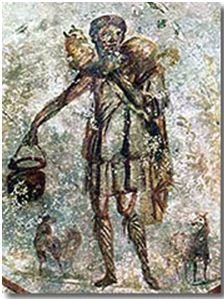
Figure 3
The shepherd depicted in this fresco is Jesus Christ (see figure. 3). The story behind this painting is that, Jesus was able to leave a large flock of sheep unattended to go and search for a single lost sheep. It shows the kind of loving attention that Jesus gives to individual amongst the multitude.
What remains of this painting is simply a rough sketch composed of plain green and soil colours. The figure in itself is smaller compared to the other paintings on the same wall (Lowden, 423).
The baptism fresco shows one larger man pouring water on the head of a smaller man. The water and the bodies of the people in the painting have been given a brownish red colour, but the water pouring on the other man has only been represented by faint lines.
The water’s layer is a greasy black paint and it only rises up to the ankle level of the two men (see figure. 4). This fresco obviously shows the baptism of a Christian. The Christians considered baptism as a ritual where one publically declared to be a Christian. Baptism was also the only way in which a Christian could attain everlasting life.
This was a significant art to the early Christians since it was a reminder of when they were spiritually ‘born again’. That meant that they officially became Christians despite of the fact that they could be prosecuted or killed as a result (Grout and Claude, 120).
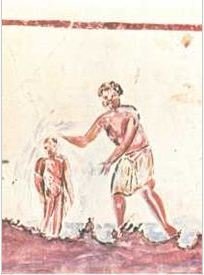
Figure 4
The fish and loaves fresco has a mixture of brown, black and grey colour. The loaves are brown while the fish has a mixture of the other colours. There are two fish lying flat and a basket of containing 5 loaves is placed on top of the fishes.
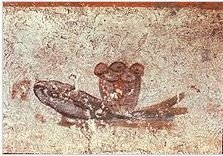
Figure 5
This fresco depicts an event in which Jesus was able to miraculously feed a multitude of people with just two fish and five loaves (see figure 5).
The early Christians were usually discriminated such that they were not allowed to own lands. This meant that they could not do any farming to feed themselves. They were basically poor hungry people (Grout and Claude, 389). Having a painting which reminded them of how their Lord is able to feed them in the catacombs, served as a source of great motivation for them.
The Eucharistic fresco in the Liberian section shows two people about to partake a meal consisting of bread and wine. The fresco painting is mainly maroon in colour with white areas.
There are dark areas which depict the outline of the images and the meal. The meal is placed on a table and the two people are standing. Eating of bread and drinking of wine is the figurative eating of Jesus’ flesh and drinking of his blood.
The Christians did this as obedience to what they were told. They were supposed to drink wine and eat bread to act as a reminder of the sacrifice which Jesus Christ gave. The painting reminded them of the love Jesus had towards them such that he was able to sacrifice his life. It helped the Christian remain faithful to Christianity despite of the prosecutions (Lowden, 567).
In these Catacombs, there are decorations like flora, vines and designed stripes and drawings. Like in other artworks, the decorations too were influenced by the pagan worship. For example, the vine decoration was meant to stand for resurrection; this is according to the pagans.
To the Christians, it was meant to represent Jesus who was resurrected after dying. Christians have hope in resurrection from the resurrection of Jesus himself, so the vine in both Christians and pagans revolve around resurrection. However, there is more to the vine than resurrection according to the Christians. The branches of the vine are meant to represent Jesus’ believers (Grout and Claude, 562).
Other symbols found in the catacombs included a peacock, a dove and an anchor. The peacock was a sign representing the immortality of the spirit. On the other hand, the dove is a symbol for harmony and joy of the heart. Finally, the anchor is a figurative of the trust Christians have on Jesus Christ.
In the sea world, the anchor is supposed to firmly hold a ship at a dock. Likewise, the faith and hope Christians have in Jesus, is meant to keep them strong and firm. The anchor gained more meaning when it was turned such that it looked liked a cross. Trust in Jesus depicted the safe harbour of deliverance which was a result of his renaissance after death (Lowden, 603).
Conclusion
The Catacombs of San Callisto are full of Christian historical information. In the catacombs, one can learn how the Christians developed from the time they were discriminated to the time when their religion was made legal. The extent of persecution is very well depicted and also how the Roman regime influenced Christianity. Also, it is during these harsh times that some of the symbols used up to today were formulated. They might have been influenced by the pagan worship, but in the modern time, it does not seem to matter.
The fresco paintings themselves were not pieces of art to be adored. Compared to what was done by the Romans, the Christian art was crude and outdated. Despite of this, these artworks are very rich because of the history they hold.
Works Cited
Athnos, Gregory. Reflections at the Catacombs. New York: McGraw-Hill Book Company, 1997. Print.
Gough, Michael. The Origins of Christian Art London. London: Thames and Hudson, 1973. Print.
Grout, Donald J and Palisca V Claude. A History of Western Christianity. New York: WW Norton and Company, 1996. Print.
Lassus, Jean. The Early Christian and Byzantine World. New York: McGraw-Hill Book Company, 1967. Print.
Lowden, John. Early Christian and Byzantine Art. London: Phaidon Press Limited, 1997. Print.
Milburn, Robert. Early Christian Art and Architecture. Berkeley: University of California Press, 1988. Print.